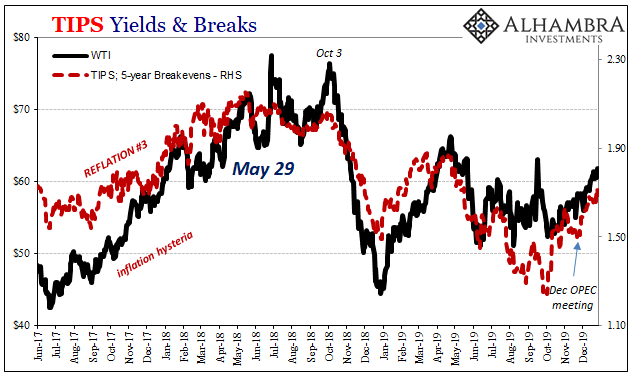While the world tries to digest the latest in geopolitics, as well as guess what could come next with them, on the topic of the economy the TIPS market registered a notable high yesterday. The 5-year breakeven rate, the difference between the “real” yield on the 5-year TIPS and the nominal yield for the 5-year US Treasury Note, was pulled up to 172 bps. It hadn’t been that much since early last May.
In fact, all the inflation expectations and breakevens have been moving higher. This would appear to be consistent with the idea that the global economy is on the rise again, especially given purported US economic strength (unemployment rate) combined with the Federal Reserve’s considerable alleged aid (repo, not-QE) and insurance (rate cuts).
The TIPS market is, after all, a primary target for the central bank. No, not in terms of bank reserves due to QE (which is buying up only T-bills) but mostly as this market can help officials project the “right” set of expectations. Higher inflation breakevens is exactly what Jay Powell wants to see at this point.

But there’s a catch (as usual). That’s not all Jay Powell wants out of the bond market, the whole bond market. Remember, TIPS and Treasuries together amount to two parts not just the one in the form of inflation expectations. There are real growth expectations to be considered, too.
That’s where the TIPS market begins; the breakevens as merely the bridge between them and nominal Treasury yields. And we know, as we have been reminded again today, nominal yields haven’t moved all that much from their September lows.
Like TIPS, they are higher than the were a few months ago but inflation expectations have outpaced them pretty significantly.
What the Fed ideally would like from the Treasury and TIPS market is for both to move upward together. Rising nominal yields plus rising inflation expectations would mean the bond market as a whole can project that economic rebound everyone now talks only about. Real yields would have the space needed to further trade in that direction, indicating an inflationary economic breakout in all phases.

Instead, it’s simple mathematics that are not in Powell’s favor. Stubborn nominal yields plus rising expectations leave the bond market a position for only lower and lower real growth. While the 5-year TIPS breakeven rises to the highest in seven months, the other part, the real yield, has fallen to the lowest in years.
Whatever might be driving inflation expectations the Treasury market is not buying them as far as how that might positively affect the overall economy.
Looking back at recent months, we see how breakevens eventually bottomed out during the second week in October while the Fed’s repo operations were ongoing and just before the FOMC would announce its not-QE small-scale asset purchase.
While that may account for the shift in TIPS inflation expectations, the more likely suspect is WTI. Oil prices had changed direction a week before TIPS, starting off on a rising trend that continues right through into 2020.

Like the 5-year breakeven, WTI is back above $60 for the first time (apart from the September Saudi refinery attack) also since early May.
Is the oil market pricing reflation as it relates to the Fed’s renewed balance sheet expansion (what everyone still mostly calls “money printing”)?
Or is it the combination of OPEC (and scaled-back US shale production projections) and the dollar?
The dollar’s exchange value hasn’t been as high of late, and the global oil cartel keeps planning and executing supply restrictions. In early December, member states agreed to another 500k bpd reduction on top of those already in place. Larger than analysts (whatever that means) were expecting, the total removed supply is now 1.7m bpd extended into at least March 2020.
You can see it on the chart above; it was the OPEC deal that began the 5-year breakeven’s jump up to its most recent local high.
Taken altogether, what the bond market is suggesting is that inflation expectations are rising (realistically meaning less low) not because of economic acceleration, rather due to another potential economic “headwind.” The lack of follow-through in nominal yields, and therefore tumbling real TIPS yields, literally does not add up to the worst-is-behind-us narrative.
And all that before today.

Stay In Touch